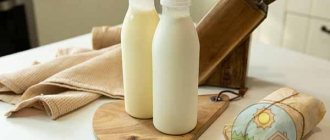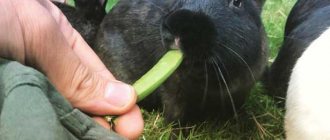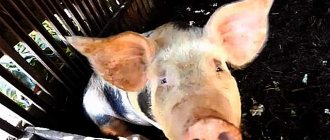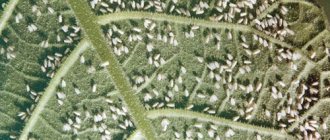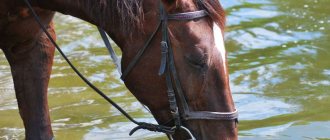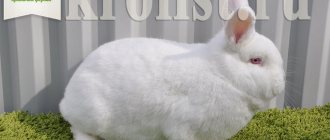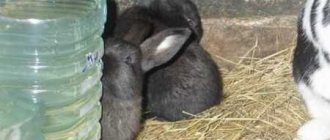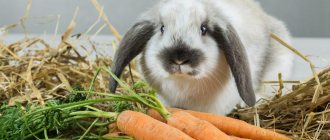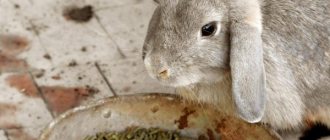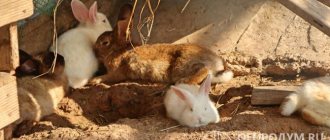Hay plays an important role in a rabbit's diet. In the wild, it serves as the basis for animal health, strengthens teeth and affects intestinal functions. If interruptions occur in the gastrointestinal tract, this leads to death.
At home, rabbit breeders do not always have the opportunity to give their pet fresh grass or greens, so they stock up on hay for this purpose. It retains all the properties necessary for growing healthy individuals.
- 1 Rabbit diet
- 2 The need for hay for a rabbit
- 3 Hay rates
- 4 Types of hay 4.1 Purchased
- 4.2 Granular
Rabbit diet
Health, fertility, and coat condition depend on how balanced the rabbits' nutrition is. Feeding them grass alone is not enough. They need to receive nutrients, minerals, vitamins. For this purpose, several types of feed have been developed, which in combination with grass will only bring benefits.
Hay is a roughage feed that is introduced in the autumn-winter period due to its high fiber content. This group also includes hay meal, straw, bark and tree branches.
Among other types of food, it is worth noting green (tops of root crops, greens, etc.) and juicy (root and tuber crops), which are added to the diet in the summer, concentrated (cereals and legumes, including oats, peas). It is also useful to give your rabbits minerals and vitamins, especially sprouted grains.
It is important that all animals have free access to clean drinking water at all times.
What to do if your rabbit doesn't eat?
Even though hay is a natural element of a rabbit's diet, animals may refuse to eat. Why don't they eat:
- don't like the taste;
- excess nutrition of grain or industrial feed.
Most often, owners of decorative breeds of animals face this problem.
To accustom rabbits to plant foods, you need:
- Replace the product (switch to another brand).
- Leave complementary foods within close reach of the animal.
- Place a special hay feeder.
- Build hay toys to increase interest.
- Add some dill, fennel or basil for flavor.
- Reduce the volume of other feeds.
- Grind hay when switching from soft food.
- Stir in bran.
Regardless of the species, all pets have conservative behavior in choosing food and have difficulty adapting to new options.
If the rabbits do not start eating the hay right away (taking into account the high quality of the food), there is no need to chew it; soon the animal will taste the herbs and switch to new food.
How to replace hay for rabbits?
Rabbits need hay; it contains special fibers, without which the normal functioning of the animal is impossible. Even greens and root vegetables cannot fully replace hay. Hay contains certain vitamins that affect the ability of animals to reproduce.
If some animal still refuses hay, you can try to compensate for it with greens, tops of radishes and carrots, leaves of cabbage, lettuce, and celery. Branches of apple trees and coniferous trees are also necessary. To replenish fiber and coarse fibers, pelleted feed should be included in the diet.
The need for hay for a rabbit
These rodents in the wild can graze on lawns for 6-8 hours every day. Hay, like fresh grass, forms the basis of rabbit nutrition. It improves digestion, maintains dental health and contains many useful substances. Its deficiency leads to malfunctions of the gastrointestinal tract. This can have a detrimental effect on the health and functioning of the animal.
It is hay that is the main source of fiber, which ensures the continuous functioning of the gastrointestinal tract, because in a rabbit this system does not have smooth muscles, and only the next portion of dense food can push through the previous one.
Rabbits chew hay constantly, at least 8-9 hours a day. The hay bolus moistened with saliva is almost constantly present in the animal’s stomach and this is a necessary condition for the proper functioning of the entire organism.
In addition, hay is rich in cellulose. This is one of the types of roughage that the rabbit constantly wears down its teeth, because they grow throughout their lives. When an animal consumes exclusively soft food, the teeth grow, damaging the eyeballs, tongue, brain and nerve endings, which can lead to the death of the animal.
Another factor indicating the important role of hay in the life of rabbits is the need to make nests from this material.
How to make a hay barn for rabbits
It’s easy to make a hay barn for rabbits at home. The choice of models is quite wide, so it is better to rely on the availability of available material and your abilities.
Work progress:
- For this model you will need a piece of metal mesh and a piece of plastic.
- The sizes are selected according to the individual characteristics of the cell (the hay should not take up the cell space).
- The mesh is bent in an L shape, and plastic is attached to the back using fasteners.
- A homemade haybox is attached to the wall using wire and nails.
This option is very convenient for replenishing supplies, and it is convenient for rabbits to pluck hay from it.
Hay rates
It is impossible to calculate the exact amount of hay. Each individual is individual. Approximate portions that should be followed are per day in grams:
- for babies up to 3 months - 100;
- for rabbits 3-6 months old - 200;
- for adults - 300.
To prepare hay for the winter, the estimated portion is multiplied by the number of days.
If, when switching from succulent and green food, the rabbit refuses to eat coarse food, experienced breeders recommend grinding it, spraying it with salted water and mixing it with bran.
Winter in Russia takes almost six months and, according to the roughest estimates, about 60 kg of hay will be needed per adult. And if we take into account the pregnancy of females and the expected offspring, then for each female rabbit this norm should be at least doubled.
The absence of special feeders in the premises also needs to be taken into account. Then the costs will be much higher, because the rabbits will steal part of the hay for nests and bedding.
Some experienced rabbit breeders make hay based on the weight of the animals. They take the weight of a rabbit, multiplied by the number of days in a year, to be equal to the required annual supply of this product for each head.
How much hay does he eat per day?
An adult rabbit eats from 250 to 400 g of hay per day. The exact amount depends on the presence of other food in the feeder (concentrates, vegetables, grass pellets), the nutritional value and quality of the hay itself.
Young animals are offered roughage at the rate of 30-100 g per head per day, depending on the age of the rabbits. It is necessary to ensure that dry grass is always in the feeder.
For pregnant rabbits, hay is a material for building a nest.
To calculate the volume of roughage for winter feeding, the number of days is multiplied by the mass of hay consumed by all animals per day. To insure against product loss and spoilage during storage, an additional 30-40% of the total mass is prepared.
Types of hay
In the summer, rabbit breeders independently prepare hay for the animals. But if this is not possible, you can purchase it at any pet store.
Purchased
When purchasing, you should pay attention to the quality of the product:
- green color - a guarantee that it was dried and stored correctly;
- no mold;
- herbal aroma;
- different types of plants, without the predominance of one particular one.
Granular
It contains the same herbs as regular hay. The preparation process is identical. The product is processed, destroying harmful bacteria, increasing the saturation of useful substances.
Advantages:
- convenient to store and transport;
- quickly and easily digested;
- has a richer taste;
- does not freeze in cold weather.
Feeding newborn rabbits
If the mother of the rabbits has died for some reason, or is capricious and does not want to feed her offspring, you can try to feed the newborn rabbits manually. Most often, when trying to feed baby rabbits with a bottle, they can die either within a couple of days, or at most within a week. Hand feeding itself does not lead to success, since mother's milk cannot be replaced one hundred percent.
The most likely cause of death is mucous enteritis. It happens that rabbits that were fed by their mother get sick with it, but most often it can happen to babies who were weaned from their mother before the age of 8 weeks. Signs of this disease include refusal to eat, severe diarrhea, and blood and mucus in the droppings. The cause of colitis may be the active growth of bacteria belonging to the pathogenic group. It (the bacterium) can develop in the appendage of the cecum just when normal microflora begins to establish there. It is this microflora that helps babies switch from milk to more solid foods.
In the stomach of rabbits, the acidity level is pH 1-2p, but in newborn babies it is much higher. In recently born rabbits, the stomach and gastrointestinal tract are sterile (that is, there are no microorganisms in it). The acidity level of baby rabbits will gradually change when they switch from milk to solid food. This process will be helped by the components that make up mother's milk.
Ten days will pass and your rabbits' eyes will open. At this time, they begin to eat the mother's caecotrophs. Caecotrophs will provide your babies with the substances necessary for the development of their body, and then later, when they switch from milk to solid food, caecotrophs will help introduce microflora into the cecum, which is so necessary for metabolism.
Cecotrophs are clusters of dung balls glued together. These caecotrophs are similar in size and shape to the mulberry fruit. They are high in vitamins K and B, as well as protein and fiber. Therefore, caecotrophs are a very important part of the diet of rabbits, and they are eaten only after emerging from the anus. When feeding baby rabbits by hand, it is necessary to provide them with the caecotrophs of an adult animal. This must be done as soon as their eyes open. As a rule, babies begin to eat caecotrophs immediately. But, if you notice that babies refuse to eat caecotrophs, you should add 2 to 3 peas from a bunch to the mixture that the rabbits eat and provide them with such nutrition once a day for 3-4 days.
Even if your rabbits have switched to adult food, be sure to monitor their droppings. Having noticed the first signs of mushy stool, immediately start giving cecotrophs again. If necessary, add them to the mixture.
It happens that the cecum of rabbits, which is sterile, cannot be populated with adult normal microflora. This directly depends not only on the nutrition of the children, but also even on stress, which affects the immune system. In this case, unfortunately, pathogenic flora begins to increase in the cecum, which leads to bloating and death from mucous colitis.
Small rabbits can quickly lose their sucking instinct, and if you hand-feed them, you should start feeding them within the first two days. If the sucking instinct has disappeared, use an insulin syringe to draw up the mixture (after removing the needle). Make sure that the rabbits do not choke, make sure that your mixture is warmed up, the babies are warm to the touch, and the syringe and bottle are sterile. This is very important, because through an unsterilized bottle or formula that you have prepared incorrectly, you can introduce quite dangerous bacteria into the baby’s fragile body.
In addition, I would also like to draw your attention to the fact that caring for newborn rabbits includes providing warmth in a basket with soft wool filling and the presence of a heating pad. It should maintain a temperature of 68-72 degrees Celsius. This temperature will be optimal for their survival. You need to keep the basket in a quiet place with minimal noise and handle the rabbits only during feeding. For feeding, you can use a milk replacer for kittens. Add a tablespoon of cream there, which should correspond to the calorie content of natural rabbit milk. You can try feeding your babies evaporated milk or goat milk, adding three tablespoons of karo corn syrup and one egg yolk. While feeding, hold your baby on your lap, surrounding him with a soft towel. When your pets' eyes open after 10 days, you can start feeding them special pellets and hay. It is better not to give vegetables and fruits right away.
Best hay composition
To choose the right composition, it is recommended to know the preferences of the rabbit. However, it is not recommended to harvest only the grass that the animal likes most. The diet should be varied.
Monotony can cause food refusal or negatively affect the pet’s health and appearance. To prevent this from happening, herbs are added to the hay: rhubarb, dandelion, lupine, burdock, plantain, yarrow, wild sorrel, nettle. All of them are rich in calcium and vitamin D. They help strengthen bones and are a good preventive measure against rickets.
For nursing females and young animals, separate preparations are made consisting of legumes (alfalfa, clover) with the addition of wheatgrass. They do not cause stomach upset and have a positive effect on lactation.
Meadow, forest and steppe grasses in a wide range are considered the best composition of hay. Moreover, it must be dried correctly - in the open air, with periodic turning, then it will retain the maximum possible amount of vitamins and micro- and macroelements.
In addition to the above-mentioned herbs, important components of hay are shepherd's purse, wild dill and rowan, wormwood, and chicory. These species have a pronounced therapeutic effect. Some of them increase appetite (wormwood), others help fight flatulence (dill), others prevent helminthic infestations (chicory) and can stop bleeding (yarrow).
Other hay is harvested in smaller quantities. Its portions are limited, but this composition must also be included in the diet at least two to three times a week. This is a product of leguminous herbs - vetch, sainfoin, clover, alfalfa. But the blades of grass should be small.
This is especially true for alfalfa and clover - in large quantities, these varieties can harm the genitourinary system of rabbits.
In terms of its nutritional characteristics, hay varies quite a lot depending on the composition of the grasses and the areas where it was harvested.
Thus, meadow grass contains up to 10% protein, 5% fat, 35% fiber, and its ash content reaches 9-10%. Whereas in cereal varieties specially grown by farmers, there are up to 15% protein components, and the ash content is only 5-6%.
To assess the nutritional value of hay, a special unit was developed - fodder. Hay is evaluated as follows - depending on a number of factors, it has 0.36-0.55 feed units per 1 kg.
Feeding pregnant rabbits
I advise you to pay great attention to the feeding diet of pregnant rabbits and here’s why. If the mother's body lacks nutrients, the normal development of the fetus is delayed. That is why the diet of nursing rabbits should contain both oats and mixed feed, legume grains (80-100 g); As a protein feed, you can add sunflower cake or meal (30-55 g), soybean meal (up to 30 g). Juicy feeds include silage and carrots. Mineral feeds include chalk, bone or meat and bone meal (1-2 g). Don't forget about fish oil (2 g). Before breeding (approximately 5 days in advance), the amount of bulk feed is reduced, and the amount of concentrates required for nutrition is increased.
Prohibited composition of hay
Some wild herbs contain toxic substances. They are prohibited from being added to hay to avoid health problems. These are celandine, buttercup, hemlock, cherry, hemlock, foxglove, marsh marigold, spurge, dope, lily of the valley, crow's eye, wormwood, Chernobyl, lumbago, greater celandine, wild radish, aconites (fighters).
If rabbit breeders have doubts about a particular herb, it is better to abandon experiments and not put the animal’s health at risk.
Do not mow grass along highways, roads, in swamps, or in places where slugs accumulate. If the hay becomes damp during storage, becomes moldy, or freezes in cold weather, it must be disposed of.
Feed options
In order to correctly compose a diet, it is necessary to take into account the physiological state of animals, know the content of nutrients in various feeds, the role and importance of individual vitamins and microelements for the growth, development and increase in productivity of animals. Try to follow the recommended diet, this will help avoid many health problems.
Green food
From the appearance of the first spring greenery until late autumn, rabbits should have plenty of plant food. With a high water content (up to 85%), it is also characterized by a fairly high nutritional value. For feeding use:
- Sown - alfalfa, vetch, peas and other legumes, cereals - winter rye and wheat, oats, millet, Sudanese, sorghum. Introduce into the diet gradually so as not to cause gastrointestinal disorders. Cereal feed is fed before flowering, legumes - during budding and at the very beginning of flowering. Later they become coarser and their digestibility is significantly reduced.
- Wild herbs - burdock, wormwood, yarrow, chamomile, nettle, dandelion, wheatgrass, plantain, quinoa, rapeseed, sow thistle, horse sorrel. Feeding is alternated or given in the form of a grass mixture.
The list of prohibited products includes hemlock, datura, henbane, foxglove, lily of the valley, crow's eye, larkspur, poisonous wech, ranunculus, hellebore, and spurge. There is some debate about the latter plant, but it has been found that it contains a toxic substance - euphorbine. The negative effect of milkweed on the rabbit’s body has not yet been precisely described, but it is known that in some cases it can cause poisoning, manifested in digestive disorders, diarrhea and vomiting, disturbances in the normal functioning of the heart muscle, and the development of convulsive seizures.
If the animal is not treated in a timely manner, the symptoms can lead to death. You should also not feed tomato tops and use potato tops with caution - mow them 3-5 days before harvesting potatoes, gradually introduce them into the diet and do not exceed more than 15% of the green mass.
Fresh grass should be slightly withered in the sun before feeding, and garden greens should be pre-washed from the soil. Rotten and too wet green food should not be given, this also causes the risk of disease and death of animals.
Please note that monotonous feeding is not recommended. For example, if baby rabbits are given only dandelions, they will noticeably lag behind in development.
Sugar and fodder beets in large quantities are not recommended for young animals, as they have a laxative. Aromatic and bitter herbs are useful, for example: wormwood, dill, chicory, yarrow, but they should be limited to lactating females, since the milk may turn sour and the rabbits will stop eating. Parsley also has an effect on slowing down lactation. But dandelion and dill are useful to give during breastfeeding.
Roughage
Give to rabbits from late autumn to early spring. During the digestion process, a large amount of heat is released (about 1000 kcal from 1 kg of feed), which the body uses to normalize body temperature. Herb preparations are rich in vitamins, minerals, valuable amino acids, which are very necessary for a fast-growing body, and are the main source of fiber.
The needles are gradually accustomed to hay, straw (mainly used as straw flour or bedding), as well as branches of trees and shrubs. It is especially important to prepare food correctly. Properly dried herbs are green in color and have a pleasant aroma. Hay cut immediately after flowering and exposed to the sun for a long time, as well as from grass that has aged or been exposed to rain, contains less nutrients, is too hard, and is less easily eaten and absorbed.
How to feed rabbits hay and how much to give? For the season, one adult requires from 40 to 100 kg, a baby up to 4 months - approximately 10-15 kg. An adult rabbit eats about 300 g of hay per day, a baby rabbit up to 4-5 months old - 100-200 g, pregnant and lactating females - 350-450 g.
To grind down their incisors, rabbits need branches from deciduous and coniferous trees. The content of the maximum amount of useful substances is due to their preparation in June-July.
For collection, select branches with a diameter of no more than 1 cm, tie them with a broom and dry them in the shade, and young conifers can be given within a day. In the daily diet of rabbits, roughage should make up 25–35%.
Juicy food
Prevails in winter, as well as late autumn and early spring diets. It is well digested and absorbed due to the high content of structured water (up to 90%), increases the milk production of rabbits and, in general, the productivity of individuals. Can occupy a significant part of the diet: from 30 to 50%. Root vegetables, tubers, melons, and silage are especially useful. They are fed in their natural form. For example, in the fall they are mostly fresh, and in winter the frozen ones must be boiled.
Carrots occupy a special place. Unlike potatoes, beets, pumpkins, zucchini, cabbage, watermelons, and rutabaga, it can be given in fairly large quantities. The vegetable contains little fiber, up to 13% dry matter, of which 1.2% is protein, a lot of sugars, vitamins A, C, B1, B2, and minerals. Root vegetables are introduced into the diet of rabbits gradually, starting from two months and in small portions. Thanks to carrots, appetite improves, the digestive system works well, and the immune system strengthens.
Concentrated
They are the main source of protein and minerals. These feeds are divided into several groups:
- cereal grains (rich in carbohydrates) - oats, corn and rye are fed in their natural form, barley is crushed;
- legume grains (rich in proteins) - peas, vetch, sunflower, soybeans, broad beans are soaked or crushed, it is recommended to mix them with cereals to avoid problems with the gastrointestinal tract;
- oilseeds (rich in fats) - within reasonable limits, they help the body function, but due to the amount of cholesterol and vegetable fats, it is necessary to limit their consumption, for example, sunflower seeds can only be given from the age of 1 month to a rabbit, in raw form - a few grains 1- 2 times per week;
- mixed feed (have the most balanced composition) - recipes are developed by specialists based on the latest scientific data on the rational nutrition of rabbits in strict accordance with their physiological state, age and type of feeding; when feeding complete granulated food, the meat produces more protein, fat, muscle content and less moisture than when fattening with feed mixtures, they have a higher calorie content of the edible part;
- waste from technical production - this includes bran, meal, oil cake, yeast, pulp, as well as animal feed (skim milk, meat and bone meal and fish meal).
The proportion of concentrates in the diet depends on the season. In summer, the menu should consist of 30-40% concentrates, and in winter and with intensive fattening - 50-70%.
How to grow and harvest hay
For harvesting, meadow, forest, steppe and field grasses that have not entered the flowering period are selected. This type is especially useful for young animals for growth and weight gain and for nursing rabbits for prolonged lactation. Flour is ground from dried hay and added to soft feed.
Harvesting hay usually begins in May-June, and when mowing, wetlands are avoided, since such types have high acidity. Preparations of various herbs are made on the edges and lawns, and then they are dried in the shade under a canopy. They build a structure in the form of a pyramid or hedge. In this way, ventilation is provided so that the grass does not become damp and rot. In addition, this method helps preserve the maximum possible amount of useful elements and vitamins in this product.
Before mowing, the number of pets for the winter is determined and the required hay is calculated. To preserve the freshness of the grass, it is dried to a moisture content of 40-45%, crushed and canned. Store in sealed areas. In this way, feed is prepared, which is called haylage. Most often, this harvesting method is used on large industrial rabbit farms.
It is important to mow your grass in a timely manner. If you skip the flowering period or remove forbs in the rain, then most likely the hay will become moldy and spoiled, and there will be much less micro- and macroelements in it.
But wild herbs grow very unevenly, their ripening depends on the time of germination, and they are directly related to climatic conditions. Therefore, experienced rabbit breeders often arrange special plantings of forbs. They try to plant seeds as early as possible, and harvest them as soon as the first spikelets and panicles appear. This is a sign of imminent flowering.
A sunny day is chosen for mowing, then the grass is dried and arranged to dry (stakes, fences). As a rule, after six weeks, further portions of grass will grow at the mowing site, which should also be removed at the first signs of flowering.
This method helps:
- Prepare much more valuable young hay, rich in vitamins, micro- and macroelements.
- Dry the hay in small volumes, carefully and correctly.
- Turn and stir drying herbs frequently.
- If the grass grows worse the next year, this area can be sown with legumes. As a rule, they nourish the earth.
- The soil for grass does not require plowing. It is enough to scatter the seeds and lightly walk with a rake.
- You can sow clover and alfalfa separately, which are so loved by rabbits. Growing and harvesting these herbs separately will help ensure they are properly dried and controlled in animal feeds.
- Seeds for forbs for rabbits can be bought in special farm stores.
- Grain crops can be sown separately.
Blank
Plants should be mowed before they begin to bloom. The most suitable areas for mowing include forest edges, clearings, meadows, and steppes. It is necessary to mow the grass on a day when there is no precipitation.
- Shade is needed to dry the mown grass, so special sheds should be organized for this. This can be done in barns equipped with good ventilation.
- The hay must be well dried. A wet product cannot be stored for long periods of time. Before sending it to dry, the hay is slightly withered. To prevent the hay from rotting, it is recommended to dry it in small portions.
- In order for the beneficial substances to be preserved in the hay, the grass should be mowed in a timely manner. However, the period of maturity of wild plants varies. The emergence of seedlings and final ripening depends on climatic conditions.
- If hay is grown on a personal plot, then a sign that it is time to mow it is the appearance of the first spikelets and panicles. A few days after mowing, new grass will begin to appear in this place, which must also be mowed in a timely manner. The shelf life of harvested hay does not exceed one year. After this, it can only be used as bedding for rabbits.
- Rabbits do not have to make their own hay. You can buy it in the store ready-made. A combination of this type of feed is acceptable.
To choose high-quality hay when purchasing in a store, you should pay attention to its appearance, smell, color, and date of manufacture.
The color of dry hay should be green, perhaps slightly yellowed. Fractions should consist of whole, uncrushed stems. The appearance of dust on them is unacceptable. The storage period should not exceed one year. The smell should not be repulsive - the hay should smell fresh. The presence of wet spots warns that rot will soon appear and the hay will no longer be suitable for consumption.
There are different types of finished hay depending on where it was cut or what age it was intended for.
How should you dry your grass?
☎ Personally, I try to carry out the first mowing as early as possible, even before flowering begins. I turn up the grass that is cut early in the morning (I have alfalfa, wheatgrass and yarrow) in the afternoon, which helps the grass dry evenly in the swaths. The next day I collect it in windrows, where it dries for another day (in hot weather the time is reduced). On the third day, I break up the windrows and after a few hours, I collect the grass mass, dried to a moisture content of approximately 30%, into small heaps, in which it reaches its condition, and then I put the finished, green, fragrant hay under the canopy. The nutritional value of such hay is very high; you cannot buy such hay anywhere. In a good year I get four harvests per plot. The first harvest has already been placed in the hay barn for storage. But this only works when you are lucky with the weather. If bad weather does not make it possible to complete the drying process, then hay with a moisture content of 20-30% can be placed under a canopy or in a stack, sprinkled with table salt, approximately 0.5-0.7 kg. per 100 kg. hay Salt is sprinkled evenly on each layer being laid. The layer thickness is no more than 50-60 cm without strong compaction. This hay will be well preserved and is eaten with pleasure by rabbits.
☏ How can you determine the moisture content of hay? Are there devices or some external signs?
☎ There are probably devices, but I determine it in the old-fashioned way: spring grass has a humidity of 80%, summer grass is somewhere around 60%. I take 10 kg of grass clippings and put it next to the rest so that it doesn’t mix. The next day I weigh and determine the moisture content depending on the weight loss. It should be taken into account that during drying, half of the water evaporates quickly, and then the drying process slows down. So, to reduce the amount of water to 50% in good weather it takes 5-7 hours, and from 50% to 20% it takes more than two days. Young plants and legumes take longer to dry than cereals.
☏ The recommendation of sprinkling salt is very important; it will certainly help you steer in a situation when the weather is bad. In this case, salt plays the role of a preservative, just as when preparing branch feed. And as a source of microelements, salt will only benefit animals. It is part of the blood, cells and tissues. Do you agree that the hay of the first cut is more valuable than subsequent ones?
☎ It seems to me that this is true. From the first mowing, the hayfield is still not infected with weeds and poisonous herbs. There is no ragweed yet, little hemlock. True, there is a lot of dandelion, it dries longer than other grass. The grass itself is thicker in the spring; by the third mowing there is practically no wheatgrass or yarrow, but ragweed appears, although there is not much of it, alfalfa drowns it out. Hence the less dense grass stand.
How to care for a herb patch?
☏ You mentioned that your hay is primarily made up of three types of grasses: alfalfa, yarrow and wheatgrass. Is this a feature of the meadow, or do you somehow regulate the range of growing herbs yourself?
☎I harvest the grass from the area being processed (see photo). Once every five years I finely plow it, or even better, just disc it. The roots of perennial grasses are crushed and the grass stand becomes thicker. After plowing or disking, I sow alfalfa in the spring, and re-sow areas with poor germination. It must be said that alfalfa enriches the soil well with nitrogen, but nevertheless, rabbit manure applied to the soil very noticeably increases the yield.
Cultivated area with herbs.
☏ But the legume crop - alfalfa, although very nutritious, cannot be fed uncontrollably in its pure form, as it causes bloating and diarrhea. How do you solve this problem?
☎ I don’t give fresh alfalfa to rabbits; I almost give them hay, which in addition to alfalfa also contains the other mentioned herbs. My rabbits did not have any intestinal disorders, but my neighbor, after giving him a large amount of slightly withered grass, died from intestinal bloating.
☏ What is the best way to mow grass? Some harvesters try to take as much green mass as possible from the plot, in fact, they “shave” it to zero.
☎ When harvesting grass for hay, it is very important to leave stubble. Nowadays, many people use gas mowers and mow the area bare. I always leave stubble 5-7 cm high. Firstly, the mown grass dries better, and secondly, new grass grows faster. In winter, the plant lives off the nutrients in the stubble.
Advantages of feed for rabbits
- Manufactured according to recipes recommended by the VNIIKP Research Institute, they meet and exceed GOST standards.
- They are distinguished by their natural composition: they contain high-quality natural components of plant origin, mineral raw materials, as well as vitamins and microelements.
- Stimulate the active appearance of appetite, ensure rapid growth and development of animals.
- Reduce mortality of rabbits.
- They have low consumption and reduce mechanical losses during transportation and distribution into feeders.
- They do not contain pathogenic microorganisms, antibiotics, or growth stimulants.
What to feed rabbits in the winter in the countryside?
The most common food that rabbits love is carrots. It contains a huge amount of vitamin A, which animals need in winter. You can give rabbits whole carrots, or sometimes you can cut them into pieces a few centimeters long. Potatoes also serve as an excellent juicy food.
Interesting materials:
What can you do for New Year 2022? What can you stick to the joints of wallpaper? What can be treated with Bordeaux mixture? What can be treated with Fitosporin? What can you open in a small town? What can you recycle trash? What can be transported in containers? What can you give your 10 year old brother for his birthday? What can you give a man for his birthday for his car? What can you sign with a facsimile signature?
